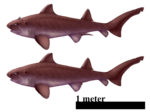Earth:Vardebukta Formation
| Vardebukta Formation Stratigraphic range: Induan ~251.9–251.2 Ma | |
|---|---|
| Type | Formation |
| Lithology | |
| Primary | Conglomerate |
| Other | Sandstone, lime mudstone, packstone |
| Location | |
| Coordinates | [ ⚑ ] : 77°00′N 16°12′E / 77°N 16.2°E |
| Paleocoordinates | [ ⚑ ] 41°00′N 9°24′E / 41.0°N 9.4°E |
| Region | Svalbard |
| Country | |
The Vardebukta Formation is a geologic formation in Norway . It preserves fossils dating back to the Induan stage (early Early Triassic).[1] Outcrops are known from the Hornsund area but also from Bellsund and Isfjorden areas.[2]
Subunits
The Vardebukta Formation is divided into the Urnetoppen Member and the overlying Wibebreen Member. Both members are of marine origin. They were deposited in a sublittoral to shallow-neritic environment.[2] The Vardebukta Formation represents the oldest Mesozoic formation in Svalbard.[3]
Urnetoppen Member
The Urnetoppen Member, which is approximately 30 meter thick in the Hornsund area, consists of greenish shales, siltstone and fine-grained sandstone, occasionally with clay-ironstone nodules. In the Hornsund area, it rests paraconformably on the Permian Kapp Starostin Formation. The Urnetoppen Member is correlated with the Deltadalen Member of the Vikinghøgda Formation, which is of Dienerian (late Induan) age.[2][4]
The top of the Urnetoppen Member contains the so-called Brevassfjellet Myalina beds, a 5–6 meter thick, fossiliferous conglomerate.
Wibebreen Member
The Wibebreen Member is ca. 90–100 meter thick in the Hornsund area. It consists of black to light-grey coloured shales, marly shales, arenaceous marls and siltstone. The lower part of this member contains mainly siltsone layers. The locally developed Skilisen Retzia Limestone belongs to the uppermost part of the Wibebreen Member. The Wibebreen Member is overlain by the Smithian (early Olenekian) aged Lusitaniadalen Member (="Sticky Keep Member") of the Vikinghøgda Formation.[2]
Paleobiota
Fossiliferous layers of the Vardebukta Formation are concentrated to the uppermost part of the Urnetoppen Member (Brevassfjellet Myalina beds). These Dienerian aged beds have yielded the bivalves Myalina and Anodontophora, crinoids, conodonts, numerous isolated fish remains, and trace fossils.[2][3][5]
Fish
The isolated fish teeth of bony and cartilaginous fishes have been described from the Brevassfjellet Myalina Bed (upper Urnetoppen Member of the Vardebukta Formation) of Hyrnefjellet, Hornsund.[2][3][6] The bony fish teeth are mostly tentatively referred to Saurichthys sp.[7]
| Chondrichthyes of the Vardebukta Formation | ||||
|---|---|---|---|---|
| Taxon / Genus | Species | Subunit | Notes | Images |
| Acrodus | A. spitzbergensis[2][3] | Brevassfjellet Myalina Bed | An acrodontid hybodontiform shark. Only known from isolated teeth | |
| Hybodus | H. microdus[2][3] | Brevassfjellet Myalina Bed | A hybodontid hybodontiform shark. Only known from isolated teeth | |
| H. sasseniensis[2][3] | Brevassfjellet Myalina Bed | A hybodontid hybodontiform shark. Only known from isolated teeth | ||
| H. sp.[3] | Brevassfjellet Myalina Bed | A hybodontid hybodontiform shark. Only known from isolated teeth | ||
| Lissodus | L. angulatus[3] | Brevassfjellet Myalina Bed | A lonchidiid hybodontiform shark (previously referred to as Polyacrodus angulatus[2]) | |
| P. sp. | Brevassfjellet Myalina Bed | An acrodontid hybodontiform shark. Only known from isolated teeth | ||
| Edestidae[2] | Gen. et sp. indet. | Brevassfjellet Myalina Bed | A eugeneodont holocephalian. Only known from two incomplete teeth | |
See also
References
- ↑ Vardebukta Formation at Fossilworks.org
- ↑ 2.00 2.01 2.02 2.03 2.04 2.05 2.06 2.07 2.08 2.09 2.10 Birkenmajer, Krzysztof; Jerzmańska, Anna (1979). "Lower Triassic shark and other fish teeth from Hornsund, South Spitsbergen". in K. Birkenmajer. Results of the Polish Spitsbergen Expeditions, Part 10.. Studia Geologica Polonica 60. pp. 7–38.
- ↑ 3.0 3.1 3.2 3.3 3.4 3.5 3.6 3.7 Błażejowski, Błażej (2004). "Shark teeth from the Lower Triassic of Spitsbergen and their histology". Polish Polar Research 25 (2): 153–167. https://www.paleo.pan.pl/people/Blazejowski/Blazejowski_etal_2004_SHARK.pdf.
- ↑ Mørk, Atle; Elvebakk, Geir; Forsberg, Arne W.; Hounslow., Mark W.; Nakrem., Hans Arne; Vigran, Jorunn Os; Weitschat, Wolfgang (1999). "The type section of the Vikinghøgda Formation: a new Lower Triassic unit in central and eastern Svalbard" (in en). Polar Research 18 (1): 51–82. doi:10.1111/j.1751-8369.1999.tb00277.x. ISSN 0800-0395. Bibcode: 1999PolRe..18...51M. http://www.polarresearch.net/index.php/polar/article/view/6558.
- ↑ Salamon, Mariusz; Gorzelak, Przemysław; Hanken, Nils-Martin; Riise, Henrik Erevik; Ferré, Bruno (2015). "Crinoids from Svalbard in the aftermath of the end−Permian mass extinction". Polish Polar Research 36 (3): 225–238. doi:10.1515/popore-2015-0015. https://core.ac.uk/download/pdf/326716427.pdf.
- ↑ Brinkmann, Winand; Romano, Carlo; Bucher, Hugo; Ware, David; Jenks, Jim (2010). "Palaeobiogeography and stratigraphy of advanced gnathostomian fishes (Chondrichthyes and Osteichthyes) in the Early Triassic and from selected Anisian localities (Report 1863–2009)". Zentralblatt für Geologie und Paläontologie, Teil 2 2009: 765–812. https://www.zora.uzh.ch/id/eprint/34071/1/Brinkmann_et_al2010_Palaeobiogeography%20and%20Stratigraphy%20of%20Advanced%20Gnathostomian%20Fishes%20in%20the%20Early%20Triassic%20and%20from%20selected%20Anisian%20Localities-2.pdf..
- ↑ Błażejowski, Błażej; Duffin, Christopher J.; Gieszcz, Piotr; Małkowski, Krzysztof; Binkowski, Marcin; Walcak, Michał; McDonald, Samuel; Withers, Philip J (2013). "Saurichthys (Pisces, Actinopterygii) teeth from the Lower Triassic of Spitsbergen, with comments on their stable isotope composition (δ13C and δ18O) and X−ray microtomography". Polish Polar Research 34 (1): 23–38. doi:10.2478/popore-2013-0007. https://journals.pan.pl/Content/99539/PDF/10183_Volume34_Issue1_02_paper.pdf.
 |



